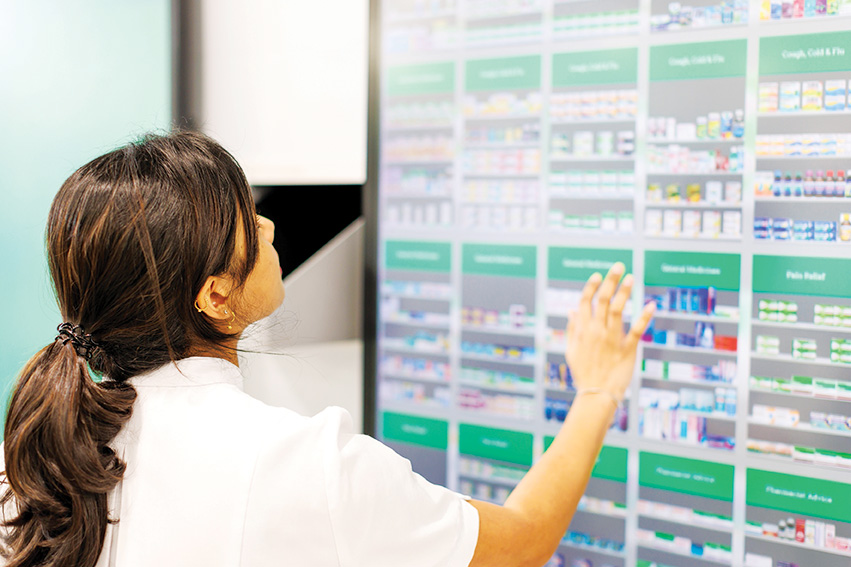Well, quite a few things, actually – from patient simulations to drudge tasks, AI can complement rather than compete with human care.
Artificial intelligence (AI) will transform pharmacy practice in Australia. Already powering comprehensive pharmacy educational tools in an Australian world-first, AI can relieve pharmacists of routine administration tasks and enable detailed tracking of patients and medicines.
AI-powered computers can perform complex tasks that once required human intelligence, such as reasoning, making logical decisions, recognising patterns and understanding speech. AI tools can complete tasks that require an employee’s time and effort, and these tools can enable rapid and comprehensive checks on human decisions.
Often not fully recognised by the people it serves, AI is already operational in many fields. OpenAI’s launch of generative AI chatbot ChatGPT in late 2022 startled the world: here was a tool that could write a reasonable essay according to minimal instructions, create images and videos, compose music and answer test questions.
On a simpler level, AI can power Google searches, match faces to smart passports, and run chatbots, and the technology is developing and becoming more sophisticated every day. Pharmacy tools powered by AI can assist with inventory management, patient engagement and chronic care management systems.1 Among an ever-expanding range of possibilities, AI tools can suggest comorbidities, answer simple customer questions, and sort through the experience and qualifications of thousands of locums to find the most suitable candidates. It can also analyse potential harmful drug interactions on multiple-medicine prescriptions more quickly and efficiently than currently possible, bringing advanced capabilities to existing pharmacy software that include better accuracy and diagnosis speed, and more specific and actionable insights for alternative medicines and dosages.
 AI tools can identify drug interactions and analyse a patient’s overall health record to enable comprehensive, tailored and personalised care.2 Vision AI or computer vision (CV), which can mimic human vision and enable machines to interpret and make decisions based on visual data (like facial recognition software), can check whether the right tablet – in terms of how it looks – is given to a patient.
AI tools can identify drug interactions and analyse a patient’s overall health record to enable comprehensive, tailored and personalised care.2 Vision AI or computer vision (CV), which can mimic human vision and enable machines to interpret and make decisions based on visual data (like facial recognition software), can check whether the right tablet – in terms of how it looks – is given to a patient.
Leading the world in AI-driven pharmacy education, PSA is now using ground-breaking AI-powered immersive simulations to train pharmacy assistants and pharmacists. Even giant US pharmacy chains have yet to launch this type of training solution at scale.
Kerri Barwick MPS, PSA’s General Manager – Education and Training, says the suite of AI learning simulations began with product knowledge units in the Certificate III community pharmacy course, and provided a ‘more learner-friendly and compliant method of obtaining performance evidence of the learner’s ability to interact with a patient’.
Before these AI modules were introduced, learners had to write a short essay about their patient interactions, and junior pharmacists often had to learn the hard way with in-pharmacy face-to-face interactions.
The AI-powered simulations are far more comprehensive than written tests, Ms Barwick says, and provide immediate feedback on learners’ communication skills and on the quality of the interaction. At the same time, the simulations are more interactive and more fun, she adds, so the learners progress through the units more consistently.
PSA provided cases for use in these training simulations, which were developed by US-based AI company Audirie. Co-founded by Australian pharmacist Michael Alexander, Audirie creates AI-powered immersive simulations that provide learners with real-time feedback.
AI-driven avatars in the PSA training simulations mimic real patients and present with complex medical histories and varied symptoms, allowing learners to hone their clinical skills in a safe and controlled environment.3 One avatar, known as “Mr Smith” is a difficult patient with a testy manner: he requires careful handling.⁴

PSA training simulations are now incorporated in the Introduction to Pharmacy in Australia course, the intern training program, in the new MMR/ACOP credential, and in future prescribing modules, Ms Barwick says.
The versatile technology allows for the introduction of whichever patient characteristics are suitable for a simulation, she adds, and the simulations respond consistently to a variety of questions asked in different ways, whether it’s gathering the best possible medication history from an elderly patient or prescribing against a protocol.
Tested for empathy and emotion in scenarios including conversations on the contraceptive pill, AI transcripts show it can give dynamic responses, with ‘surprising’ follow-up questions, rather than merely responding to a standard set of questions and answers. Ms Barwick says such situations can then be explored in further pharmacist training.
AI-powered technology will be used for all clinical conditions within the Queensland scope pilot, she says noting the pilot protocol sits in the background of the program and users provide patient parameters to drive an interaction.
‘PSA learners will be able to practise a consultation with the avatar in their own time,’ she adds. The Queensland hormonal contraceptive pilot launched in July this year and PSA’s training module for the service is now available online.
Complement not compete
Meanwhile, the wholesale transformation to AI-powered tools has yet to be widely taken up in Australian pharmacies, although some chains and owners are linking with AI startups to find innovative solutions to long-term pharmacy bottlenecks, says Mr Alexander.
At the same time, he adds, it should be recognised that AI is not a panacea, and it will never fully replace the human touch. Rather, it will free up pharmacists to concentrate more intently on each individual patient’s overlapping and interlocking health problems.
‘AI’s true potential will lie in its ability to analyse vast amounts of data with precision and speed, providing critical health insights that are currently beyond our reach,’ he says. ‘This means pharmacists can offer more precise medication recommendations, anticipate adverse reactions, and ensure that each patient’s treatment plan is uniquely tailored to their specific needs. It’s a fusion of technology and empathy, enhancing the human touch with the power of machine learning.’
At its best, he adds, ‘AI will complement and complete human-centred patient care, not compete with it’.
 Uber-tailored to patient needs
Uber-tailored to patient needs
AI can constantly monitor patient behaviour and medication compliance, use predictive analytics to determine when a patient is likely to miss a dose, and even intervene with automated nudges.
‘Beyond reminders,’ Mr Alexander says, ‘AI can get to the root of the cause and analyse why patients might struggle with compliance – be it adverse effects, forgetfulness, or a misunderstanding about their medication – and provide personalised strategies to overcome these hurdles.’ For example, he says, consider the case of hypothetical patient Emma, a 67-year-old woman with hypertension who often forgets to take her medicines. AI can analyse Emma’s behaviour and find she often misses doses when she’s away from home, travelling or at social events. AI can then create targeted interventions: possibly a simplified medication schedule or generate reminders at the specific times Emma is likely to forget her medicines, or even suggesting a support community to help her manage her condition.
‘The main takeaway is that AI can be uber-tailored to each patient’s unique compliance needs,’ Mr Alexander says.
Equally importantly, AI can evaluate enormous amounts of prescription data to find patterns and trends humans might miss, he adds, and sift through troves of clinical data to suggest the most effective treatments for individual patients.
AI-driven health data
Australia’s first AI-driven integrated public health and clinical data platform designed to assist with major current and future healthcare challenges is under construction by researchers from Flinders University. The SMART-PH platform will house real-time high-quality public health data in order to address emerging health priorities such as pandemics and natural disasters.
As well as providing new and innovative offerings, AI comes with certain challenges. Data scientist and AI auditor Mike McKenna, founder of Adjust AI and advisor to Services Australia, says AI can be extremely useful at triaging tasks. For instance, if pharmacists are under-resourced but want to follow up on the neediest patients who haven’t picked up a prescription refill, AI can sort through a hospital or pharmacy chain’s list of failed pickups* and prioritise action according to which patients are more in need of the refill.
|
AI defined Artificial intelligence (AI) is a broad term used to describe various technologies. It can be defined as intelligence in machines, particularly in computers. AI-powered machines can perform complex tasks that once required a human mind: tasks such as classifying images, analysing data and making reasonable predictions. The various models of generative AI, a popular newcomer, can generate text, images, video or other data, often in response to prompts. These models can learn from input data to generate new data, and they surged in popularity in the early 2020s. Machine learning is a form of AI, based on statistical algorithms that can learn from data sets to take on quite complicated and changing tasks without needing specific instructions. AI is a huge leap forward from automation, which is essentially a term for the way specialised technology and software can be used for certain unchanging and repetitive tasks of varying complexity – from folding cardboard boxes to assembling cars and laptops. Various types of automation are driven by mechanical, hydraulic, pneumatic or electrical power, electronic devices, and computers, usually in combination. |
|
AI in the future The next generation of AI-powered robotic systems will have the potential to revolutionise pharmacy operations: sorting through and analysing vast mines of interacting and overlapping data on medication usage, patient interactions, and workflow efficiency, says Michael Alexander, AI-powered drones might deliver medicines to bed-ridden patients, AI is already used to help design pharmaceuticals and could soon be used to develop genetically personalised medicine, with treatments specifically tailored to suit genetic makeup. Patients of the future might provide pharmacists with prescriptions that come with their complete genetic profile. Pharmacists might then use a 3D printer to print a pin-point specific drug designed to perfectly suit the patient. |
Yet Mr McKenna says this form of triage has run into difficulties in the United States in the past; that is, with certain AI systems – which sort through oceans of historical data to inform sort choices – which then deprioritises minority groups such black patients.
‘The historical triage information might have been discriminatory,’ Mr McKenna says. ‘It’s an ongoing research challenge.’
 Ethical challenges
Ethical challenges
A range of ethical challenges attend the use of AI, experts warn.
These are ‘super-varied and difficult’, Mr McKenna says, and run the gamut from legal, privacy and discrimination issues, to fairness, transparency and explainability. The popular and powerful generative AI systems launched in recent years present the most problems, he adds.
‘They have far outweighed our ability to really digest the ethical implications that are there, which reduces our ability to use those systems effectively in high-stakes contexts, like health,’ Mr McKenna says. ‘There’s a lot of pressure on execs and CEOs to leverage AI, so there’s a really intense risk calculus that has to go on.’ It remains largely unknown in important ways, he adds, exactly how these AI systems work, particularly the most advanced ones.
‘We may not know, to the level of detail that we would want to know, the reasoning behind information that AI generates about a patient,’ he says. ‘There might be legal uncertainties. It’s a real challenge for developers that build AI, and for organisations that leverage AI.’
References
- The Pharmacy Guild of Australia. From fear to opportunity: debunking myths and harnessing the power of AI in community. ITK 2024. At: www.pharmacyitk.com.au/from-fear-to-opportunity-debunking-myths-and-harnessing-the-power-of-ai-in-community-pharmacy/
- Alowais SA, Alghamdi SS, Alsuhebany N, et al. Revolutionizing healthcare: the role of artificial intelligence in clinical practice. BMC Med Educ 2023;23(689). Epub 2023 Sep 22. At: https://bmcmededuc.biomedcentral.com/articles/10.1186/s12909-023-04698-z
- Alexander M. ChatGPT gets emotional. Blogpost 2023. www.audirieintelligence.com/post/chatgpt-gets-emotional
- Pharmaceutical Society of Australia. Pharmacists in 2030 consultation paper. Deakin: Pharmaceutical Society of Australia; 2023. P. 41. At: www.psa.org.au/wp-content/uploads/2023/09/Pharmacists-in-2030-Consultation-Paper.pdf



 Professor Margie Danchin[/caption]
Professor Margie Danchin[/caption]

 Dr Peter Tenni[/caption]
Dr Peter Tenni[/caption]
 How should we deprescribe gabapentinoids, according to the Maudsley Deprescribing Guidelines[/caption]
How should we deprescribe gabapentinoids, according to the Maudsley Deprescribing Guidelines[/caption]



 Pharmacists have always prescribed, but they have the potential to prescribe much more
Pharmacists have always prescribed, but they have the potential to prescribe much more




